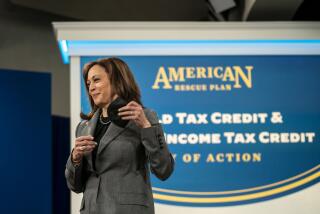Nader Offers Plan for S&L; Bailouts : Activist Seeks Higher Taxes on Rich, Levy on Stock Trades
- Share via
WASHINGTON — Consumer activist Ralph Nader, calling the Bush Administration plan to bail out the savings and loan insurance fund “too unjust a solution for the country to tolerate,” on Wednesday announced a drive for higher taxes on the rich and a levy on stock trades to pay for the S&L; cleanup.
“If the bankers and the bureaucrats think they can resolve this on the backs of taxpayers, they are wrong, just as (former President Ronald) Reagan and (House Speaker Jim) Wright were on the congressional salary grab,” Nader told a news conference.
His remarks were the opening rhetorical salvo in a “financial democracy campaign” that has the backing of the Rev. Jesse Jackson and officials from labor and consumer groups, among them Citizen Action, the Communications Workers of America and the Service Employees International Union.
They see S&L; bailout legislation as an opportunity to require banks and S&Ls; to help finance cut-rate mortgages for new home buyers and to make funds available to build low-cost housing for the poor. Under Nader’s plan, these institutions would be required to invest in a national development pool that would provide financing at below-market rates.
The campaign, which will begin formally next month, may have considerable influence because Nader is a close ally of House Banking Committee Chairman Henry B. Gonzalez (D-Tex.). At his first news conference after being elected chairman of the committee in December, Gonzalez made a special point of discussing his strong relationship with Nader.
Gonzalez will preside over preparation of the S&L; legislation in the House. He has already warned that the bill may need to contain measures to prevent S&Ls; and banks from passing along higher premiums on deposit insurance to their middle- and low-income customers. The Bush plan calls for spending $126 billion over the next 10 years to dispose of financially crippled S&Ls;, either by shutting them down and paying off depositors or by selling the institutions to outside investors. The money is needed to restore the solvency of the federal insurance fund, which guarantees S&L; deposits up to $100,000.
Suggested Sources
The taxpayer contribution would be about $40 billion, with the rest coming from the insurance premiums paid by banks and S&Ls; and from the sale of real estate and other assets at failed institutions.
Nader suggested four alternative sources for the money:
* An increase in the top marginal tax rate to 33% for persons in the highest bracket, about 1% of the population. Because of an “accident” in drafting the law, Nader raid, the rate climbs to 33%, then drops back to 28% for the wealthiest taxpayers--married couples with taxable income of $149,250 or more and single persons whose taxable income reaches $89,560.
* A transaction tax of 0.5% on all stock sales.
* Excise taxes on investment fees connected with takeovers and buyouts, and new excise taxes on mutual funds, “junk bonds” and mortgages on luxury homes.
* A 10% surtax on the corporate income tax.
Each source could generate revenue of about $10 billion a year, Nader asserted.
Neighborhood groups of poor and middle-income people will join the campaign to avert a general taxpayer bailout of the troubled S&Ls;, said Elena Hanggi, former president of the Assn. of Community Organizations for Reform Now, which boasts 75,000 member families in 26 states.
“We did not create the S&L; mess, we did not benefit and we will not pay for it,” she told reporters at the news conference. The President’s plan will cost the average taxpayer $500 or more, she said.
“I don’t know about you, but I don’t have a dollar to donate to bail out crooks and incompetents,” Hanggi said.
During the congressional debate over expanded bank powers last year, her group, commonly known as ACORN, pushed for amendments requiring banks to offer basic checking services to their poorest customers.
ACORN is “opportunistic, pushing their version of social engineering,” said Fritz Elmendorf, spokesman for the Consumer Bankers Assn., who attended the Nader press conference.
Bankers are “keeping hands off, not asking for new powers” as part of the legislation that will rescue the S&L; insurance fund, Elmendorf said. While Congress considers this issue, bankers have put on hold their drive to get into underwriting and selling securities and insurance, two lines of business denied them under current federal banking law.
However, that position could change if debate over the S&L; bailout becomes entangled with other issues, Elmendorf warned. The bankers might be forced to reopen their drive for new powers “if the legislation bogs down and other people like ACORN push their own agenda.”
More to Read
Get the L.A. Times Politics newsletter
Deeply reported insights into legislation, politics and policy from Sacramento, Washington and beyond. In your inbox twice per week.
You may occasionally receive promotional content from the Los Angeles Times.










